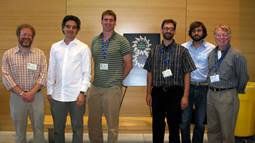Predictions, Proteins and Peptoids
 Photo courtesy of Berkeley National Laboratory
Photo courtesy of Berkeley National Laboratory
The principal investigators of this study together at the recent 8th Peptoid Summit at the Berkeley Lab Molecular Foundry. From Left to Right: Ron Zuckermann, Kent Kirshenbaum, Glenn Butterfoss, Vincent Voelz, Richard Bonnaeu, Ken Dill.
Mark Twain purportedly once observed, "It is difficult to make predictions, especially about the future."
Yet predictions are an important part of the progress of science. Researchers regularly propose how the world works, or at least how they think it works, and then test their ideas against Nature's toughest mirror, reality itself. The predictions that hold true—and the methods that make them so—are not only breakthroughs in themselves, but also a means to new innovations and new applications.
Recently, a group of researchers supported by the Office of Science's Lawrence Berkeley National Laboratory (Berkeley Lab) successfully predicted how a few small peptoids, the synthetic cousins of proteins would take shape—research that might eventually lead to a number of new possibilities in both the medical and the materials sciences.
Proteins are cellular machines—they make things go—and when they go bad, so can the cells in which they operate. Proteins are built from long chains of amino acids, and how they fold together largely determines how they function. As a consequence, scientists are striving to predict how proteins fold together; how they reach their proper forms so they can fulfill their proper functions (see Unfolding a Better Future).
Scientists are also interested in predicting how synthetic cousins of proteins, known as peptoids take shape. Unlike proteins, most of which spend their time in the watery environments of cells, peptoids hold together even when not surrounded by H2O. In addition, cells aren't able to break down peptoids as easily as proteins. Both of those characteristics make peptoids potentially useful for a wide range of applications including antimicrobials, platforms for delivering medicines and even therapeutics in their own right. And since peptoids also are more stable when exposed to chemicals and heat than proteins, learning how to design and direct the assembly of such tiny machines might lead to many other advances in materials sciences such as directing more energy efficient ways of synthesizing mechanically strong materials and sequestering carbon dioxide.
However, to build designer peptoids, scientists have to first build computer models that accurately predict how they will fold together. That's where Berkeley Lab came in. Specifically, researchers at its Molecular Foundry (http://foundry.lbl.gov/) proposed a contest: Scientists would use their computer models to predict the 3-D structures for three different peptoids whose actual forms had already been figured out.
Perhaps to the scientists' surprise, their models worked…and even better than expected. The teams predicted the shape of the largest peptoid tested to an accuracy of one Angstrom, one ten-billionth of a meter. (By comparison, one Angstrom is about the diameter of a hydrogen atom—a human hair is roughly 800,000-1,000,000 Angstroms across.) And in their best effort, researchers correctly predicted the shape of a smaller peptoid to an accuracy of two-tenths (0.2) of an Angstrom.
The superlative accuracy of the outcome is notable enough. But the process that led to the prediction is even more important. It's a proven step toward designing peptoids and developing minute machines that might one day add immeasurable value to people's lives.
Assuming the peptoid programs continue to hold true, this particular outcome is pretty easy to predict: A future of progress and new possibilities thanks to the Office of Science.
The Department's Office of Science is the single largest supporter of basic research in the physical sciences in the United States and is working to address some of the most pressing challenges of our time. For more information please visit http://science.energy.gov/about. For more information about Berkeley Lab, please go to http://www.lbl.gov/.
Charles Rousseaux is a Senior Writer in the Office of Science.

